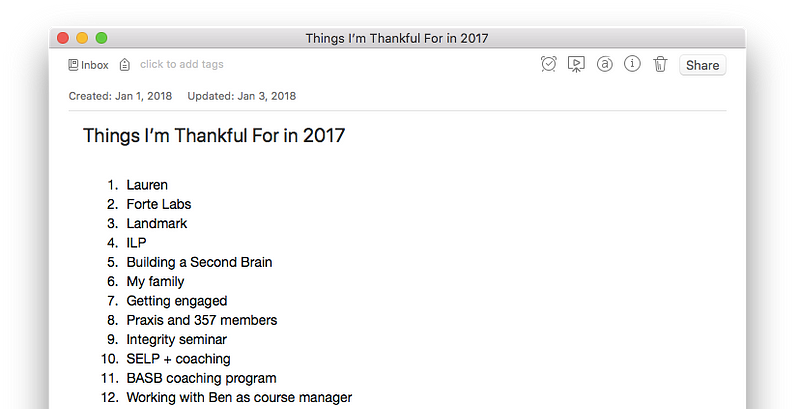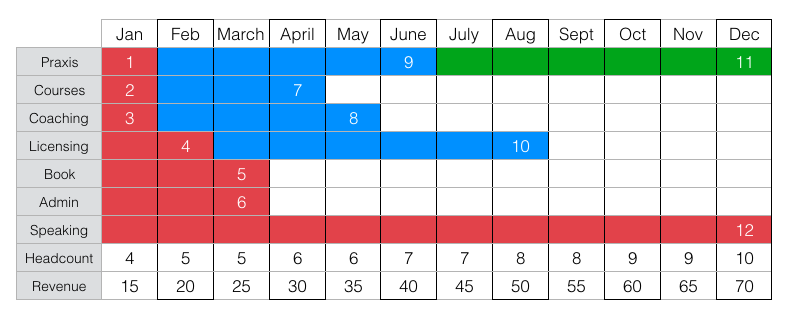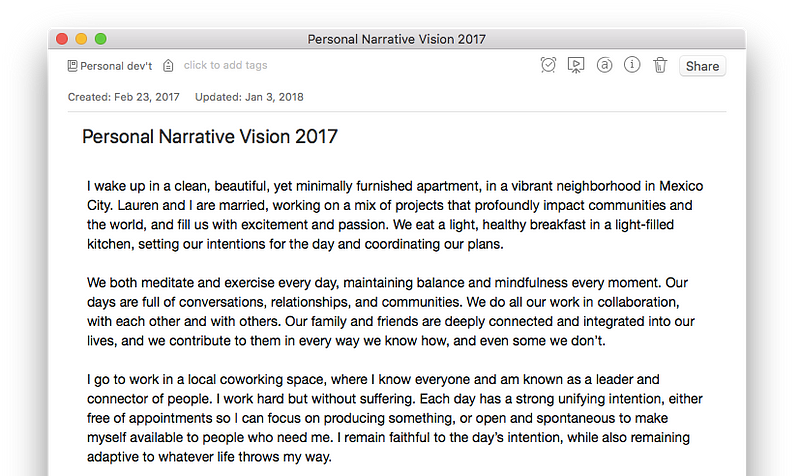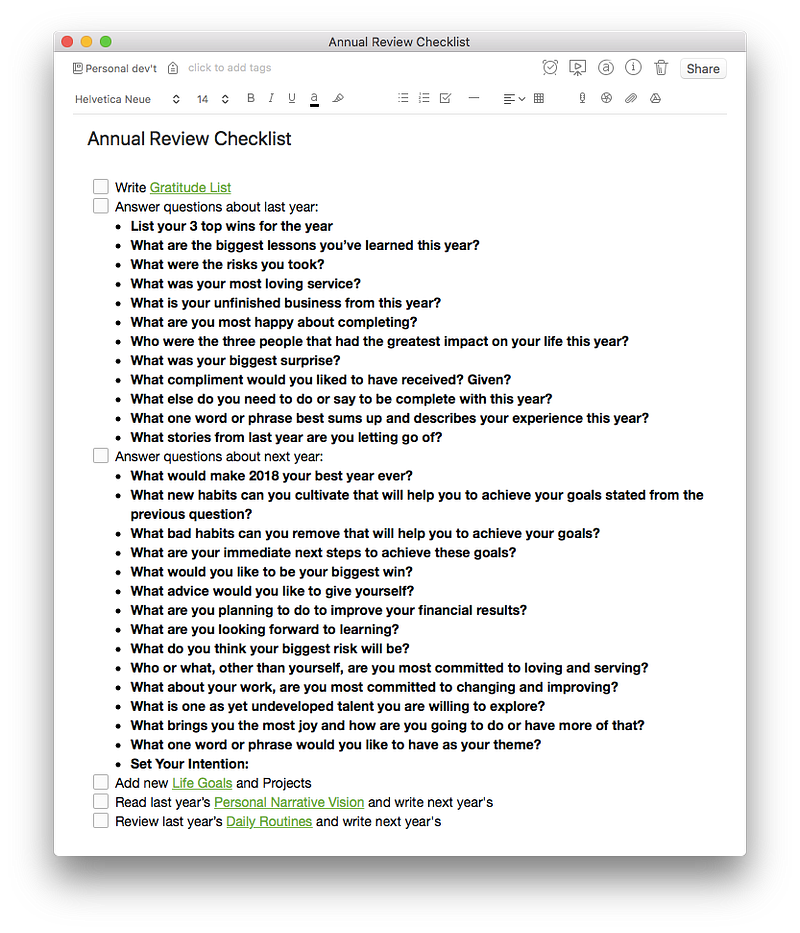I previously described how the weekly review is an operating system, funneling each bit of information you captured during the week to its proper place. I also described the monthly review as a systems check, periodically making sure your systems are in good working order.
Now we’re ready to dive into the annual review, which I think of as a “life rearchitecture.” Like all high-level strategic planning, you’re not actually doing anything. You are taking the 50,000 foot view, and making conscious adjustments to the narrative by which you live your life.
☐ 1. Write Gratitude List
This is my longest standing yearly ritual, which I’ve done every year since 2008. It’s also the simplest: I sit down and I make a list of every single thing I’m grateful for from the past year, which tend to fall into 7 categories:
- Experiences
- People
- Accomplishments
- Learnings
- Events
- Circumstances
- Things
I don’t follow any order, procedure, or template for how to think of them. I may glance over my calendar from the past year, the archived projects in my task manager, or my journal. But in general it is a freeform brainstorm. I just let the gratitude flow.
Every year, no matter how much I got done, I always find there is a hidden narrative lurking in the back of my mind that “I didn’t accomplish enough this year.”
Making this list, which usually reaches 60–90 items, obliterates that story every time. I simply can’t face a list of 78 things I’m thankful for (this year’s count) and feel anything but an overwhelming sense of gratitude.
You can read more about this exercise in What I Learned in 7 Years of Tracking Gratitude. Here’s a sample of this year’s list for you to get a sense of how straightforward it is:

☐ 2. Answer questions about last year
I like the questionnaire format, because it removes the expectation that what I write must be profound or noble. I ask myself the following questions about the past year, and then answer them as honestly as possible.
- List your 3 top wins for the year
- What are the 3 biggest lessons you’ve learned this year?
- What were the risks you took?
- What was your most loving service?
- What is your unfinished business from this year?
- What are you most happy about completing?
- Who were the three people that had the greatest impact on your life this year?
- What was your biggest surprise?
- What compliment would you liked to have received? Given?
- What else do you need to do or say to be complete with this year?
- What one word or phrase best sums up and describes your experience this year?
- What stories from last year are you letting go of?
☐ 3. Answer questions about next year
- What would make 2018 your best year ever?
- What new habits can you cultivate that will help you to achieve your goals from the previous question?
- What bad habits can you remove that will help you to achieve your goals?
- What are your immediate next steps to achieve these goals?
- What would you like to be your biggest win?
- What advice would you like to give yourself?
- What are you planning to do to improve your financial results?
- What are you looking forward to learning?
- What do you think your biggest risk will be?
- Who or what, other than yourself, are you most committed to loving and serving?
- What about your work, are you most committed to changing and improving?
- What is one as yet undeveloped talent you are willing to explore?
- What brings you the most joy and how are you going to do or have more of that?
- What one word or phrase would you like to have as your theme?
- Set Your Intention:
☐ 4. Add new Life Goals and Projects
The previous steps set the stage for reviewing and updating my goals.
The Gratitude List puts me in a positive, abundance-oriented mindset, seeing clearly how much is possible in just a year. And answering the questions above explores the nooks and crannies of my desires, hopes, and intentions, many of which I’ve been reluctant to articulate.
Because I’ve already updated my goals as step 1 in my monthly review, I focus now on creating new ones. Here’s what I came up with for 2018, only 5 of which already existed in some form:
- Migrate Praxis blog to new WordPress/Memberful site, maintaining customer experience and adding new features, by Jan. 31, 2018.
- Launch self-paced version of Building a Second Brain with coaching option, by Jan. 31, 2018 (+1,000 graduates in Q1).
- Launch coaching pilot and sign 10 paying clients by Jan. 31, 2018.
- Establish solid working relationship with a lawyer, by February 29, 2018.
- Write and publish Building a Second Brain book, with 100,000 copies sold, by March 31, 2018.
- Establish effective, automated business finances (incl. estimated tax payments, expense-tracking, payroll, business financial goals, retirement contributions, quarterly financial reports, insurance, savings) by March 31, 2018.
- Enroll first 5 participants in online course incubator program, by April 30, 2018.
- Establish FL coaching program as sustainable revenue stream with 5 coaches, 50 clients, generating $18k per month in recurring revenue, by May 31, 2018.
- Complete series with 20 episodes of impactful, convincing, simple blog posts teaching people about TOC and connecting principles of flow to knowledge work, by June 30, 2018.
- FL content is licensed to 5 people or businesses, producing $5k per month in revenue, by August 31, 2018.
- Praxis reaches 1,000 paying members, by Dec. 31, 2018.
- Deliver at least 5 talks at major conferences or other events, by Dec. 31, 2018.
- Build a team of 10 world-class collaborators, by December 31, 2018.
My main criteria for formulating these goals, besides the S.M.A.R.T. guidelines explained in the monthly review, is that they have to scare me. They have to be goals I don’t know I can reach using existing skills and resources. That high bar right from the beginning provides the background pressure to look for new sources of leverage all year long.
Then I create any new projects that are needed to start taking action on the goals above, for example:
- Meal planning
- Personal budget
- Payroll setup
- Mexico City move
- Public speaking coach
- Lawyer setup/licensing
- Coaching program
- Praxis migration
- Learning to draw
- BASB book
- BASB self-paced
- Praxis vol. II
- Storm of Tweets book
- BTOC republishing
This isn’t quite as simple as generating one project for each goal. Some goals can be reached directly with a single project, whereas more ambitious ones may require a group of projects, in parallel or one after the other. Other projects are not directly tied to specific goals, but play more of a supporting role (like meal planning, payroll setup, and learning to draw).
This year, for the first time, I made an extremely simple calendar to give myself an idea of when my various goals need to be started and finished. Anyone with any experience in formal planning will be scandalized, but this is meant to be a quick and dirty overview, not a detailed plan.
The white numbers correspond to the goals above:

☐ 5. Read last year’s Personal Narrative Vision and write next year’s
For years I struggled to find a way to “review” my Areas of Responsibility (long-term, ongoing responsibilities like Health, Finances, Travel, Apartment, or Spouse).
Areas tend to change on long timescales of months or years, which means there never seems to be a “right time” to evaluate them. Checklists and other analytical approaches don’t work, because these areas of our lives tend to be integrated and holistic, not black or white.
I came up with the Personal Narrative Vision (PNV) exercise to approach it from a different angle. I realized that the natural way to think about the balance of activities in one’s life is through stories. The PNV is a detailed account of what the different areas of my life will look like a year from now.
I start by reading the previous year’s and noting anything that was off base, unrealistic, or too ambitious. Then I write a new story for the coming year, in the present tense:
- I start with the basics: where I live, what my home is like, what I have for breakfast, how I feel when I wake up.
- I list my habits: when and how I exercise, meditate, cook, go to work, and wind down in the evening.
- I describe my work: what kinds of projects I’m committed to, the kinds of people I work with, what my experience of work is like, how I collaborate, how the business is run, how the business is growing.
- I describe my relationships: with my partner, my family, my friends, my neighbors, and my collaborators.
- I describe my partner Lauren’s life: what she is working on, what kinds of hobbies she is pursuing, what kinds of people are in her life, her accomplishments.
- I describe how I am learning and growing: what kinds of experiences I am seeking out, the kinds of lessons I am learning, the wisdom I am gaining, the purpose I am living into.

This isn’t a brief story. This year’s came out to 2,100 words, or about 4 pages. My goal is to describe every aspect of this future life in as much juicy detail as I can muster.
My goal is not to try and predict exactly what my life will look like a year from now. I really have no idea. I do it to recruit the emotions and unconscious processes of my limbic system as allies in creating the conditions I want to grow and thrive.
It’s similar to visualization — once the mind can imagine something, it starts to see ways of making it real. When I can practically taste the food I want to be eating and can vividly imagine the sunlight streaming through my future windows, it all feels very tangible and possible. I start to notice all sorts of opportunities to subtly (and sometimes dramatically) alter the direction I’m headed.
It’s important to hold this narrative lightly, even as you give yourself permission to fill in all the details. Life always proves far more interesting (and occasionally more ambitious) than our imagination, and being open to serendipity is just as important as any goal.
☐ 6. Review last year’s Daily Routines and write next year’s
The final product of all these questions and checklists is not, surprisingly, goals or projects or visualizations. It is my Daily Routines list, a concise summary of the habits, routines, and rituals I’ll need this year to make everything else possible.
I start by reviewing the previous year’s list, noting anything that was unrealistic or irrelevant. Then I make a chronological checklist of the daily and weekly habits I am committed to for the coming year, broken down into 5 sections:
- Morning habits
- Midday habits
- Evening habits
- Bad habits to avoid
- Weekly practices
I can then put these on the calendar, write them on a stickie note by my computer, set alarms on my phone, or put other structures in place to make good habits more likely to happen and bad habits less likely.
Turning over a new leaf
In spite of all the hype around New Year’s Resolutions and the cliched slogans (“new year, new you”), I always find there is indeed something meaningful about the end of the year.
It’s like a jubilee, your failings and mistakes cleared away to make room for a new chapter. There’s no magical transformation in your habits and mindset, but there is a small burst of motivation. You can try and use that temporary energy to spark momentum. But in my experience that game is bound to fail for most people.
I prefer to spend that motivation on an Annual Review. To shape my own perspective toward what I want, rather than what I have. To view my life through the lens of what is possible, instead of what is known. I force myself to be so practical all year long — this is my chance to dream a little. I always find that a little bit of this perspective can have a profound effect on my perception of my circumstances. And perception is the precursor to any kind of action.
As a final step — optional but highly recommended — I suggest sharing the results of these exercises with the people who are important to you. Share them with your partner, your family, your friends, and your colleagues. Make it a discussion. Answer the questions together.
Making your goals and intentions known to the people you spend your life with also makes them more real. We are fundamentally social creatures. Sharing these deep-seated desires alters how people see us and listen to us. It doesn’t replace the need for action, but can often recruit them into helping or supporting you.
Taking the time to perform an annual review is the most effective way I know of to edit your own narrative and be the author of your own life. Don’t miss the opportunity.
Follow us for the latest updates and insights around productivity and Building a Second Brain on Twitter, Facebook, Instagram, LinkedIn, and YouTube. And if you're ready to start building your Second Brain, get the book and learn the proven method to organize your digital life and unlock your creative potential.

